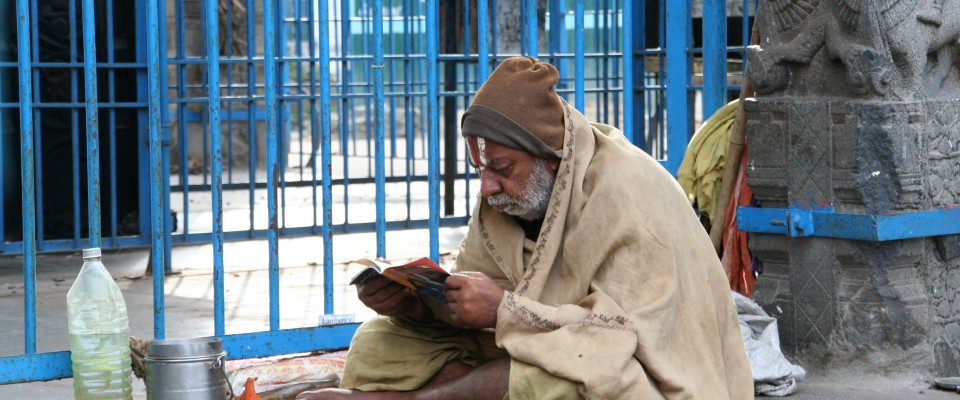One of India’s seven sacred cities (its name comes from `Puram`: city, and `Kanchi`: gold, which makes Kanchipuram, `the golden city`), it was the capital of the Pallava dynasty for several centuries. Also known as `the city of 1000 temples`, of which one can still find about one hundred – witnesses of its history – whose walls seem to be singing mantras. Kanchipuram attracts millions of Shivaite and Vishnuite pilgrims.
The city is also well known for its hand woven silk saris, very appreciated for weddings, but one piece of advice: do not buy them there, they are more expensive than in Chennai. However, do go and visit a silk weaving workshop, it is very interesting.
It is very old, dusty city, without charm except for the undeniable beauty of its temples with their magical atmosphere.
The entry to the temples is FREE. It is also possible to hire a guide. The temples are open from 6h30 to 12h30 and from 16h to 20h. Prepare small change for shoe keepers, beggars and the numerous priests …
Below are the three temples not to miss, either because of their architectural beauty or for their sacred and religious atmosphere.
Kailashanath Temple (Pallava, 700/728) is dedicated to God Shiva (Mount Kailash is the mythical abode of Shiva). A bit isolated, 2 km outside the city to the west, this relatively small, but extremely beautiful edifice was built under the reign of King Rajasimha and King Varman III, his son. It is the most famous, the most beautiful and also the oldest Pallava temple; it is still almost intact. Due to its sobriety, specialists consider it a masterpiece of Dravidian architecture and sculpture.
It is accessed through the garden, which gives a sense of harmony to the place. Then you go through a small gate to access the sanctuary. After the small gopura adorned with deity figures and various motifs, you are in the inner courtyard. Opposite the entrance, a wonderful Nandi (the vehicle of Shiva).
The inner cloister gives a certain serenity to the place. In the outlying cells that accompany the inner enclosure there are numerous statues, as well as traces of ancient wall frescoes, from the 8th century. This is the most interesting part of the temple.
The temple is covered with statues coated in white stucco. Shiva is venerated under the form of the lingam in the cella (Holy of Hollies), accompanied by Parvati.
Kailashanath Temple
Ekambareshvara Temple: huge 9a temple, dedicated to Shiva. You enter the inner courtyard passing through an enormous gopura, 60m high, dating from 1509. The mandapa (`hallway with a thousand pillars` – in reality 540) at the entrance of the temple is a big hallway with sculptured granite pillars, opened towards the outside. Here, examine thoroughly the numerous sculptures on the pillars; they are all different. Note the Nandi facing the temple entrance. A bit further, on the left, you will see the Kalyana Mandapa.
The famous sacred mango tree, 3500 years old, is situated in the inner courtyard; it is considered to be the axis of the world. From its four branches giving fruits of different flavours, representing the four Vedas, there are unfortunately only two left. It is here that Shiva and Kamakshi (Parvati) got married (as did JC and Anne). Outside you will find the ablution basin. If you ask the permission, you can climb up to the top of one of the gopurams.
Ekambareshvara Temple
Varadaraja Swami or Devarajswami Temple, dedicated to Vishnu, is 1 km away from the city in the direction of Mahābalipuram. The temple is surrounded by a high massive stonewall. Once you have passed by the gopura at the entrance, on your left there is a wonderful 96 pillars mandapa; on the finely crafted pillars you will see several good representations of the 10 incarnations of Vishnu. On the left side of this mandapa, you can see, hanging from the roof, a chain carved from a single block of granite. It is the most interesting part of the visit, as non-Hindu are not allowed inside the temple. At the back of this mandapa, there is big purification ablution basin. In front of the main entrance there is a big djavasthamba (standard bearer), a long brass pole that supports the temple banner, and a Nandi.
Varadaraja Swami
Practical information:
- This small city is only 66 km away from Mahābalipuram and 60 km away from Chennai (Madras). Do not spend the night there, the hotels are modest and often dirty, like in all pilgrimage places.
- The temples are quite a long way away from each other. Rent a bike or, after having negotiated the price, hire the services of a rickshaw for the day (800INR).
- You have to pay a fee for taking photos (20 INR) and videos (100 INR). Look after your ticket carefully.
